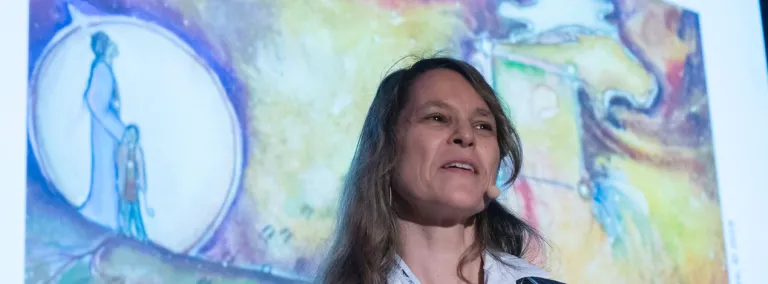One sky, many worlds: Annette S. Lee to keynote Neutrino Day 2021
Speaker will explore Lakota/Dakota Indigenous astronomy and combining perspectives to understand the world around us.
A group of 800 young stars blaze in a corner of the night sky. Of these hundreds, just six are visible from Earth with the naked eye. Known to the western world as the Pleiades constellation, these six shining lights have spurred ages of storytelling.
Ancient Greeks immortalized the daughters of Atlas in this constellation, each visible star embodying one daughter’s soul. To the Ininew Cree tribes, who gazed at the Pleiades from the other side of the globe, the stars mark Pakone Kisik, the Hole in the Sky, where Star Woman fell through the sky and became the first human on this planet. To the Lakota people, who see the night sky as a mirror of the Black Hills, the constellation is a stellar reflection of Mato Tipila, or Devils Tower.
When particle physicists look at the night sky, they see arching starlight as proof of the existence of dark matter. Some astrophysicists study stars as cosmic cauldrons, creating elements such as carbon, calcium and iron. Other astrophysicists use stars as “standard candles”—mile markers in the vast regions of space.
“The sky is embedded with stories from all of humanity, throughout all time,” said Annette S. Lee. An astrophysicist, artist, educator and Native sky watcher, Lee views the stars through more lenses than most. As the keynote speaker at Sanford Underground Neutrino Facility’s (SURF) Neutrino Day: Star Chronicles, Lee will describe how we can all better appreciate and share humanity’s collective knowledge of the night sky.
“It’s not like we’re just outside observers watching this,” Lee said during an interview with Science Friday. “The key thing is we’re a part of it.”
Lee’s talk, entitled “Two-Eyed Seeing: Paha Sapa, the Black Hills, and the Heart of Everything that is,” will explore Lakota/Dakota Indigenous astronomy and the practice of combining perspectives in order to gain a better understanding of phenomena that surround us. This virtual talk will take place at our Neutrino Day finale on Saturday, July 10, at 4 p.m. MT. As an astronomer, Lee has researched the chemical atmospheres of stars, examined the night sky from Whipple Observatory, studied high-resolution spectra of starlight and digitally imaged galaxies captured by the Hubble Space Telescope.
Lee is mixed-race Lakota and her communities are Ojibwe and Dakota/Lakota. Her understanding of the stars is deeply rooted in Indigenous knowledge.
“I walk through life with a deeply Indigenous approach,” Lee wrote to the American Association for the Advancement of Science (AAAS).
As she learns more about the stars through science and Indigenous knowledge systems, Lee has transformed that understanding into art. A professional visual artist of more than 30 years, Lee collaborated with others to paint several sky star maps based on Ojibwe, D/Lakota and Ininew/Cree star knowledge. The maps chart each culture’s constellations, describing their location, seasonal movement, relationship with other astronomical objects and the stories each constellation tells.
Lee’s astronomical research, Native understanding and art have all culminated in an educational mission. “Public engagement is not an afterthought, it is a necessity for survival, like breathing,” Lee wrote to AAAS.
In 2007, Lee launched Native Skywatchers, an initiative that aims to record, map and share Indigenous star knowledge. The program creates culturally responsive curriculum and teaching strategies, anchored in Indigenous knowledge systems. Native Skywatchers draws on the collective expertise of Indigenous knowledge keepers, scientists, artists, educators, youth and community members in an effort to improve education inequalities faced by native youth, cultivate cultural pride and promote community wellness.
In a swirl of painting, teaching, stargazing and data-taking, Lee’s efforts turn her audiences’ attention to the skies above. Join Lee at SURF’s free, virtual Neutrino Day finale on Saturday, July 10, at 4 p.m. MT. Attendees can join the event through our virtual Neutrino Day town or live on Facebook, Vimeo, YouTube and www.neutrinoday.com.
